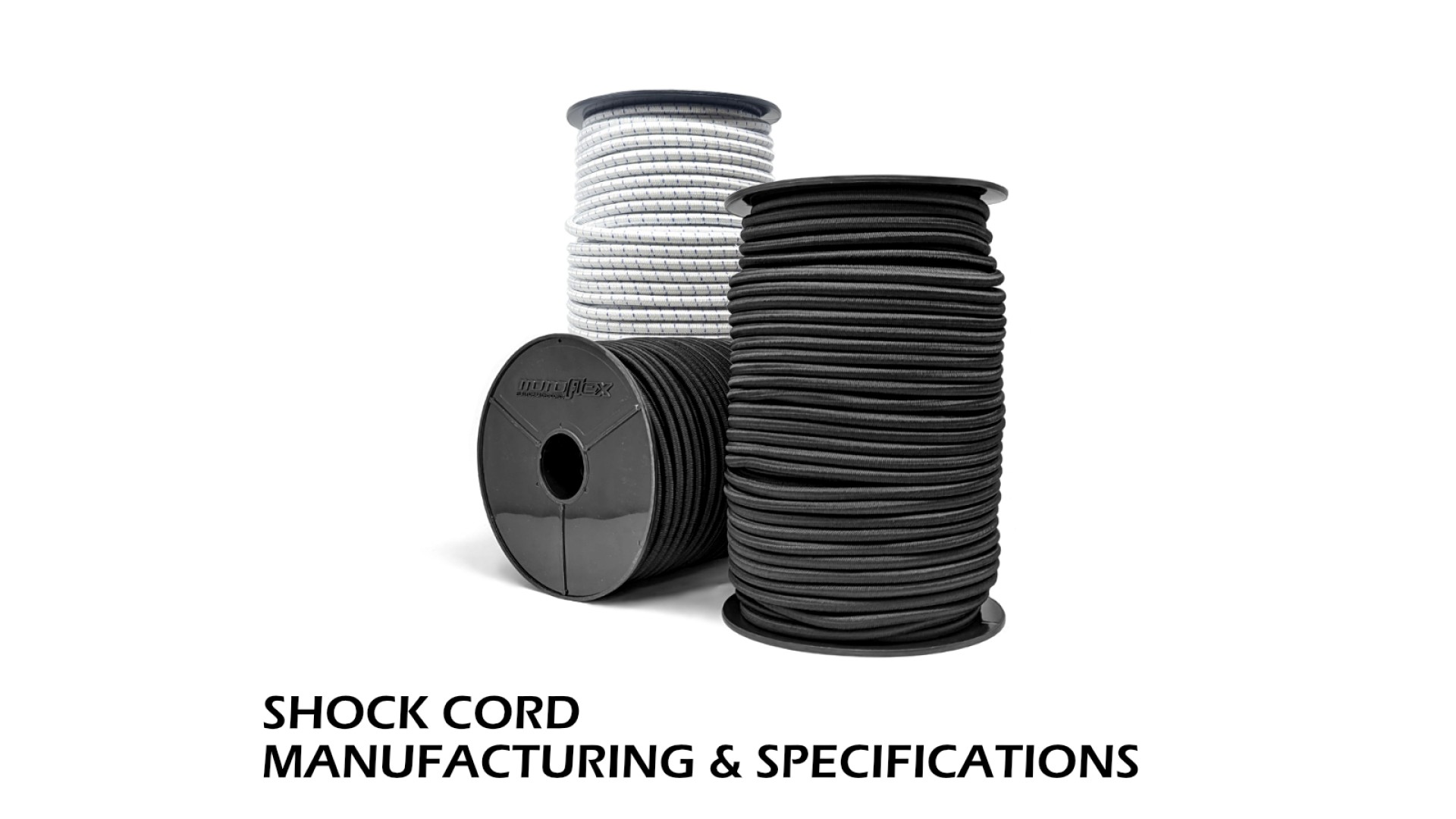What Is Shock Cord?
Shock cord (sometimes called bungee cord or elastic cord) is a flexible, braided elastic cord used in tensioning, securing, or absorbing shock in technical and commercial applications. Unlike static rope, shock cord provides controlled elasticity, allowing it to return to its original length without loss of performance—an essential property in systems requiring dynamic movement or repeated flex.
Terminology Clarification:
- Shock Cord – Unfinished cord supplied in bulk or cut lengths
- Bungee Cord – Often refers to finished assemblies with end fittings
- Braided Rubber Cord – Formal technical term (e.g. BSI)
- Occy Cord / Elastic Rope – Regional/common names
At PT Winchester, we use "shock cord" to refer to the raw braided product, and "bungee" for finished assemblies using our range of components to suit the end application.
Construction & Materials
Considering the versatility of this product, shock cord is only made from two components: the rubber core and the outer sheath. The best descriptive term for it as a whole would be Braided Rubber Cord.
The Core
The core delivers the elastic performance and is typically made from natural or synthetic rubber. At P T Winchester all our shock cord is made from Natural latex rubber for its excellent elasticity, fatigue resistance and tensile strength. We prioritise solid-core, Monoflex®, natural rubber across most of our 5mm+ stock for greater performance consistency and load handling.
- Single (Monoflex®) Rubber Core - Preferred for durability and high tensile resilience.
- Multi-Strand (Multiflex®) Rubber Core - Offers greater flexibility in smaller diameters.
The Sheath
The braided outer layer protects the core and determines abrasion and UV resistance, as well as the aesthetic finish and any specialist requirements:
- Polypropylene - Lightweight, economical, low resistance to stretch.
- Polyester - High abrasion and UV resistance, suitable for marine and harsh outdoor environments. Increased resistance to stretch over the Polypropylene.
- Nylon/Cotton - Available upon request for specific tactile or design needs
Performance Considerations:
As with all our range of products as PT Winchester there is no low-quality option, rather options suited to different end uses, Shock cord is no different. When deciding what is right for your job you need to consider what is important to the application such as,
- Load tolerance and recoil strength
- Weather and UV resilience
- Surface grip and handling
- Colour coding for functional or branding needs
Material Interaction & Construction Notes
- A tighter or denser braid increases surface protection and limits overstretch but may dampen rebound.
- A looser braid allows greater stretch and rebound freedom but offers less protection to the rubber core.
- Pairing a natural rubber core with a polyester sheath yields a dependable balance of stretch, rebound, and environmental resistance — ideal for most commercial applications.
- Synthetic rubber cores may stretch less but perform better in temperature extremes, oils, or chemical exposure.
For a more in-depth comparison on sheath types see our post - Understanding Shock Cord Braid Materials
Common Applications
PT Winchester shock cords are used across sectors for secure fastening, flexible tensioning, and movement control. Key industry applications include:
Transport & Logistics
- Load restraint on trailers, pallets, and vehicles
- Securing tarpaulins and netting
- Fast attachment mechanisms in delivery operations
Covers, Events & Temporary Structures
- Tensioning tents, marquees, and canopies
- Securing PVC banners, signage and partitioning systems
- Pop-up and mobile structural rigging
Automotive & Accessory Fitting
- Cord integration in bags, panniers, cargo straps
- Bungee systems in sports, tactical, and transport gear
Certain specialist applications such as bungee jumping, fall-arrest systems, orthotic medical devices, and firefighting gear, require technical-grade shock cords that are specifically engineered, tested, and certified to meet stringent safety, mechanical, and environmental standards.
While PT Winchester shock cords are not manufactured for life-critical or regulated safety systems, they are trusted across multiple commercial and industrial sectors for reliable performance in flexible tensioning, controlled movement, and secure fastening. Our focus is on durability, consistency, and practicality, delivering dependable solutions for logistics, structures, equipment integration, and day-to-day operational use. Looking to specify for one of these uses? → Talk to our team
Choosing the Right Specifications
We touched on it earlier in Construction & Materials but selecting the correct shock cord is essential for product reliability and repeatable performance.
Key Specification Factors to Consider
- Tensile Resistance - Indicates how much force the cord can resist while stretched. A higher tensile strength is critical for load bearing or safety-critical uses, while lower ratings may suit light-duty fastening or positioning tasks.
- Stretch Ratio (Elongation %) - Most shock cords offer controlled stretch between 100%–120% of their original length. Beyond this range, performance and rebound consistency may degrade. Applications requiring dynamic movement or shock absorption should stay well within this working stretch range.
- Diameter - Larger diameters increase overall tensile capacity and tension force but may reduce flexibility or compatibility with smaller fittings. Smaller diameters are better for discreet routing, softer tension, or lighter loads. Always match cord diameter to hardware compatibility and ergonomic handling needs.
- Environmental Resistance - Sheath material governs exposure performance:
- UV Stability for outdoor use
- Abrasion Resistance for high-contact or moving parts
- Moisture/Water Resistance for marine, transport, or weather-facing applications Choose sheath materials like polyester or TPU coatings for long-term outdoor use and avoid cotton or untreated nylons where water absorption or degradation may occur.
- Colour - More than just aesthetic — colour can assist in:
- Load identification or function coding (e.g., red = heavy, blue = light)
- Visual safety/contrast (e.g., black cord on light banners, or high-vis yellow in site work)
- Brand consistency in customer-facing products or accessories
Spec Consistency Is Critical
Inconsistent rubber or braiding results in unpredictable stretch and return. Our Monoflex® range ensures batch-to-batch uniformity, ideal for OEMs, kit builders, and repeat-volume users.
We Support:
- Sample matching
- Technical datasheets
- Informed recommendations based on intended use
Custom Assemblies & Trade Supply
In addition to supplying shock cord by the reel, PT Winchester offers custom-assembled bungee cords tailored to your operational needs.
Options Include
- Pre-cut lengths
- Crimped or looped ends
- Plastic or metal hook fittings
- Carabiners, toggles, and cleats
- Colour-coded assemblies for process or product lines
All assemblies are made in-house to ensure spec control and lead time reliability.
Follow the link to view our Bespoke Bungee Assemblies Page
Why Choose P T Winchester
- ✅ Consistent Spec, Batch to Batch
- ✅ Fast Dispatch from Stock
- ✅ Trade Pricing & Volume Discounts
- ✅ Custom Assembly Capabilities
- ✅ UK-Based Support for Technical Matching
- ✅ Direct from Manufacturer Supply Chain
Whether you need a dependable off-the-shelf product, or a bespoke solution built to spec, our shock cord stock is trusted by trade buyers across the UK and beyond.

